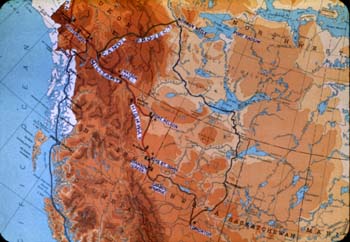
Unofficial views: Phillip Neal
Phillip Neal was in the U.S. Army 341st Engineers General Service Regiment, constructing the Alaska Highway from Dawson Creek to Fort Nelson, B.C. He also served in Whitehorse at Northwest Service Command Headquarters where he was in charge of vehicle maintenance for the Alaska Highway and the Canol project, 1942-1945. Mr. Neal donated his collection of films, slides, and sound recordings to Yukon Archives in 1993. The slides are organized in the form of a slide show that is narrated by Mr. Neal on his sound recording. The complete slide show, including 140 photographs, is presented here along with the transcribed sound recording (Yukon Archives. Phillip Neal fonds, 93/9, SR 165 (1)).

A map showing the Alaska Highway and Canol project. ca. 1942-45
The other major project essential to the success of the Alcan Highway was to develop an adequate fuel supply in that isolated section of North America, and this was the Canadian Oil [Canadian American Norman Oil Line] or Canol project. The magnitude of this project, to develop an oilfield, lay 600 miles of pipeline from Norman Wells to Whitehorse, build a refinery in Whitehorse and lay 900 miles of pipeline up and down the Alcan Highway, required a consortium of three major contractors, Bechtel, Price and Callahan. It was started in June of 1942 with 2500 engineer troops plus the civilian contractors’ employees. Supplies had to be moved by rail from Edmonton, Alberta, to the end of steel at Waterways in Northwest Territory [Alberta]. Then up 1100 miles by water to Norman Wells on the Mackenzie River where a small oil field had been discovered back in 1920. The only means of transportation were boats in the summer and dogsleds in the winter.
At Waterways, barges were built for water transportation 450 miles down the Slave River to Great Slave Lake which is the 5th largest lake in the North American continent. Then 150 miles across the lake and finally 500 miles down the Mackenzie River to Norman Wells. On the North American continent, the Mackenzie River is second only to the Mississippi in length and drainage area. The freeze-up came in October and that stopped the river traffic so the troops had to build a thousand-mile long winter road down the Mackenzie River to keep the supplies moving until spring. Before the project was finished, 60-70,000 tons of supplies had been moved over that 1100 mile water route to Norman Wells. Reconnaissance flights to locate the 600-mile route from Norman Wells to Whitehorse began in June of 1942.
Yukon Archives. Phillip Neal fonds, 93/9 #83, PHO 437At Waterways, barges were built for water transportation 450 miles down the Slave River to Great Slave Lake which is the 5th largest lake in the North American continent. Then 150 miles across the lake and finally 500 miles down the Mackenzie River to Norman Wells. On the North American continent, the Mackenzie River is second only to the Mississippi in length and drainage area. The freeze-up came in October and that stopped the river traffic so the troops had to build a thousand-mile long winter road down the Mackenzie River to keep the supplies moving until spring. Before the project was finished, 60-70,000 tons of supplies had been moved over that 1100 mile water route to Norman Wells. Reconnaissance flights to locate the 600-mile route from Norman Wells to Whitehorse began in June of 1942.






